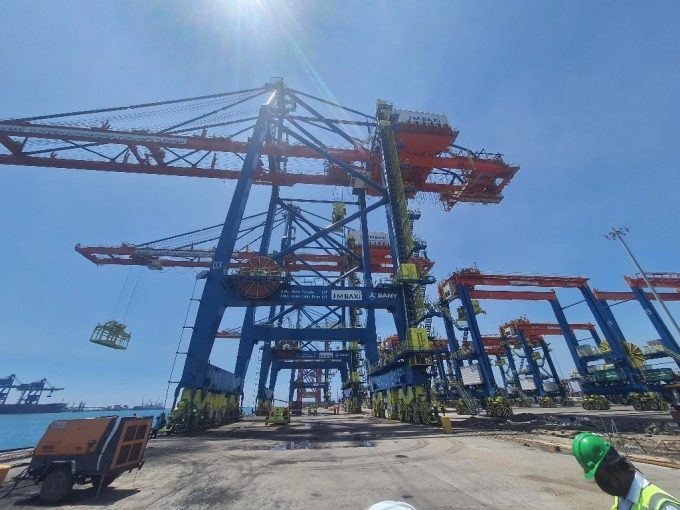Mærsk Line shoots to the bottom of earnings/teu league
Carriers’ unit earnings tell the story
KNX: 'HARRIS UPSIDE'R: PRICEY BUT WORTHYGM: AUTO VERTICAL WOESWTC: NEW RECORDDHL: THE DAY AFTERZIM: UNSTOPPABLECHRW: NEW HIGHMAERSK: PORT DISRUPTION SURCHARGEKNIN: CEO ON ROADWMT: SUPPLY CHAIN MERGER UPS: STANDARD SATURDAY EXPANSION DHL: BULLISH STANCE REITERATED
KNX: 'HARRIS UPSIDE'R: PRICEY BUT WORTHYGM: AUTO VERTICAL WOESWTC: NEW RECORDDHL: THE DAY AFTERZIM: UNSTOPPABLECHRW: NEW HIGHMAERSK: PORT DISRUPTION SURCHARGEKNIN: CEO ON ROADWMT: SUPPLY CHAIN MERGER UPS: STANDARD SATURDAY EXPANSION DHL: BULLISH STANCE REITERATED

Container lines extending operations beyond the ocean leg is a trend gathering momentum in India, as the carriers differentiate themselves with integrated supply chain solutions amid evolving market dynamics.
Most liner heavyweights have established a terminal presence at busy Indian gateways, with the latest to join that select group being Hapag-Lloyd.
A 600,000-teu terminal at Tuticorin Port (renamed VO Chidambaranar) in southern India, a joint project built by Mumbai-based JM Baxi Group and Hapag-Lloyd, went live this week, just as the Gemini Cooperation, between Maersk and Hapag, takes broader shape.
The German carrier, through recently rebranded terminal arm Hanseatic Global Terminal, acquired a 40% stake in JM Baxi Ports & Logistics early last year.
JM Baxi claims the new terminal has significant growth potential, due to its proximity to the main east-west international shipping lanes and sophisticated infrastructure, citing a 370-metre quay, draught of 14.2 metres and easy inland access.
“The inauguration marks a major milestone in India’s maritime sector, further strengthening the country’s port infrastructure and boosting trade opportunities across south India and beyond,” said the company. “It will enhance trade operations across the region, acting as a gateway for east-west trade routes.”
The concession for the project involved converting and refurbishing one of Tuticorin’s bulk berths into a box facility, at a cost of some $52m.
The inaugural call at the new terminal was made by the Rio Grande Express, one of the vessels deployed on Hapag-Lloyd’s weekly south-east India-Europe (IEX) loop that began in 2019 as the first regular direct long-haul connection out of India’s east coast.
The IEX, however, has had serious schedule reliability problems since the pandemic era, which have exacerbated since the Red Sea crisis.
A year ago, Hapag-Lloyd switched IEX calls from DP World Chennai to Adani Ports’ Kattupalli Port. Sources believe IEX calls could again be relocated to Tuticorin on a fixed basis, giving the new terminal a headstart, given the port capacity scenario.
Tuticorin has two other box terminals – PSA Sical, embroiled in tariff disputes, and Dakshin Bharat Gateway Terminal, with ownership interests for MSC through its acquisition of Bolloré Africa Logistics, with combined throughput capacity pegged at 1.2m teu annually. Fiscal year 2023-24 port volumes stood at some 750,000 teu.
MSC is already driving significant operational gains from its dedicated terminal operations in the Chennai region, which include a recent 49%-buy into Adani Ennore Container Terminal. Additionally, the Adani-MSC joint-venture at Mundra Port is the busiest box facility in India.
CMA CGM also has a strong terminal footprint in India, with operations at Mundra and Nhava Sheva through joint-venture arrangements.
Dedicated terminal presence typically offers considerable operational flexibility for ship operators, especially in the disruptive environment created by the Red Sea crisis.
The market region around Chennai has considerably raised its trade development profile in recent years, with intra-country manufacturing diversification. The area is known for automobile and electronics verticals.
Although cargo volumes have picked up, due to recent import surges, new entrants have some oversupply to deal with, and this is expected drive intra-regional terminal competition. Adani’s Vizhinjam container transhipment terminal is drawing headlines as a potential alternative to Sri Lanka’s Colombo Port.
While it’s too early to draw conclusions, large transhipment volumes through Vizhinjam could also open new feeder opportunities for other smaller ports, including Tuticorin, as such cargo needs local relays or re-handles.
“With full operations set to commence, the Tuticorin terminal will revolutionise container handling in South India, significantly reducing transit times and boosting trade volumes,” claimed JM Baxi.
Comment on this article